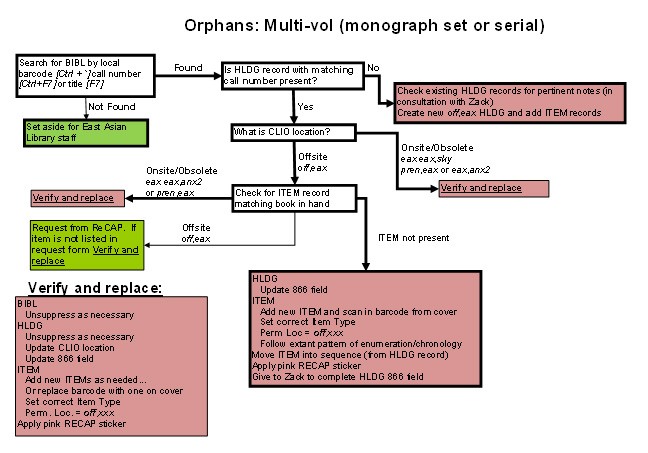East Asian Library
General Collections
C.V. Starr East Asian Library has transferred collections to ReCAP since the facility opened in 2002. Collections include mainly printed books. Some microfilms, videos and un-processed archival materials have been accessioned. It has four corresponding CLIO locations assigned for off-site collections:
- off,eal : general collection of western language, circulating monographs and serials (circ)
- off,ean : special collection of non-circulating materials (noncirc)
- off,ear : special collection of restricted material (noncirc)
- off,eax : general collection of vernacular language, circulating monographs and serials (circ)
- off,eaa : special collection of non-circulating materials (noncirc)
East Asian Library collections correspond to four different customer codes:
- CR : allow delivery to all CUL libraries
- CU : allow delivery to all CUL and ReCAP partner libraries
- EA : allow delivery only to East Asian Library Circulation Desk
- EV : allow delivery to all CUL and ReCAP partner libraries (obsolete)
Customer codes AR and CV are used by East Asian tech services staff when processing Avery Library and Butler Media Center collections respectively. These items will be transferred to ReCAP from Starr.
ReCAP processing is a continuous, ongoing project at East Asian. East Asian Library has progressed through many phases of barcoding. Previous phases included transferring Nippon Decimal classification and crowded areas of LC classified stacks. A long-term phase of smart barcoding began in Summer 2009: 2009-present (CU6). In 2001 smart barcodes were generated for single-item microfilms (CU7).
Collections have been transferred from several physical locations: all East Asian Stacks levels inlcuding reference, the Annex, and new acquisitions transferred directly to ReCAP. Collections had formerly been stored in four offsite locations: Prentis, Lehman, Business Library storage, and Health Science Library storage. These were consolidated at Annex and later transfered to ReCAP. In 2011 transfers began from the Tibetan Reading Room at Lehman Library.
On the annual (estimated) ReCAP quotas, East Asian Library has typically been allocated approximately 25,000 volumes for collection growth offset.
CLIO Location Displays

- off, eal
Display "Offsite" matches other, circulating collections that have CU barcodes.

- off,ean
Corresponds to customer code EA. Deliverable only to East Asian Library Circulation Desk; non-circulating. To be used by patrons, under staff supervision in the Kress Reading Room.

- off,ear
Corresponds to customer code EA. Requires staff place Restricted Access Request. Deliverable only to East Asian Library Circulation Desk; non-circulating. To be used by patrons, under staff supervision in the Kress Reading Room.

- off,eax
Display "Offsite" matches other, circulating collections that have CU barcodes.

- off,eaa
Corresponds to customer code EA. Deliverable only to East Asian Library Circulation Desk; non-circulating. To be used by patrons, under staff supervision in the Kress Reading Room.
Notes
Staffing
- East Asian Library has historically supervised in-house staff to select, process and prepare collections for transfer to ReCAP. CJK language skills are needed to process collections. Documentation is separate from centralized procedures of MRP.
- Processed collections are staged to allow retrieval for patrons, grouped in some measure by classification.
- Links to documentation to be added after WCM transition to Day CQ.
ReCAP Transfer Schedule
- Transfers to ReCAP
Upcoming schedule, transfer history and information about transfer/courier services between CUL and ReCAP.
Smart Barcoding
- Smart barcodes have been used for several phases of transfer. Use of smart barcodes intended to make selection and processing more efficient.
- Staff generated barcodes across entire collection in two batches. First batch was approx. 40,000 and included Reference and Special Collection items by accident. Reference location is denoted by $k REF in the HLDG record (carry over from NOTIS); Special Collections denoted by $k SPECCOLL and in HLDG record. Second batch of approx. 23,500 corrected error and excluded Reference and Special Collections. Criteria: 1) Pub date range: 1900-1998, CLIO loc eal or eax, no RARE, REF, REF2 or SPECIAL in 852 of HLDG and no circulation after 1998.
- ReCAP Coordinator began project to follow up on leftover smart barcodes. Initial survey (sheets 217-227 and 281-290) indicated 16.7% of items were not found on shelf during first check with smart barcodes. Classification range included PL; reference and special collections had not been excluded.
High Use Titles
- Discussion between Ria Koopmans-Debruijn, Sarah Elman and Zack Lane on September 28, 2009. Notes of meeting are posted here. The main topic was the potential to de-accession high-use titles from ReCAP and reshelve them onsite at East Asian. Conclusion was that no immediate action will be taken on returning items to campus do to complexity of factors involved. More information needed to separate data for monographs from serials.
Orphan Barcodes
- Discussion of East Asian Library orphan barcodes began in July 2010. Orphan barcodes are off-site barcodes that are both accessioned at ReCAP and not entered in Voyager. They represent lost books that are unavailable for request.
- Initial survey found 3,697 barcodes with customer code EV; 2 barcodes with customer code EA. Master list of East Asian orphan barcodes
- In August 2010, a project began to systematically resolve all East Asian orphan barcodes with customer code EV.
East Asian DVDs
Starting from January 2011, all East Asian stand-alone video recordings will be processed for the Butler Media Center. Feature films (i.e., movies) and documentary films on DVD/VCD will be shelved in the Butler Media Center. VHS as well as other types of DVD/VCDs will be processed for the ReCAP.
There has been concern about security of DVDs. Staff considered de-accessioning high-use titles and changing the CLIO location of all videos at ReCAP. Since videos are non-circulating to all patrons except Officers, it was necessary to guarantee the delivery location has viewing equipment. BMC is the only department that has this equipment easily available for extended hours. The documentation about these issues can be found here.
Staff concluded that high-use titles would not be deaccessioned.
In August 2011, all off-site DVDs owned by East Asian Library were flipped to off,bmc/resvideo, approximately, 1,800 items. These items now appear in the accession statistics for BMC. Past requests for these items are counted in East Asian statistics. Post-flip requests are tallied for BMC.
Table of Contents
- [TK]
Archival Collections at RECAP
- Barbara Curtis Adachi Bunraku Collection, 1964-2003 (Partly in Starr, party in ReCAP). Finding aid. BIBLs: 6226404 (Bunraku off,ear) and 6602506 (Hands of Japan off,ear)
- Makino Mamoru Collection on the History of East Asian Film (in process; partly in Starr, partly in ReCAP). BIBL: 7755896 (off,ean). Unprocessed collections were assigned CU8- prefix barcodes (off,eax) and sent to ReCAP with minimal BIBLs for later retrieval and processing.
6154403 : Eiga Kanren Takno-bon
6154404 : Eiga Panfurettorui
6154399 : Meijiki Taishoki Kosho.
6154401 : Satsueijo Kanren Shiryo.
6154402 : Sengo (1940-
6154400 : Senzen
6154398 : Shoshi kansren.
6154405 : Tsuika Shiryo
6169912 : Videotapes.
- The Tibet Information Network (TIN) Archive: files of the London Headquarters, 1989-2003 (in process; partly in Starr, partly in ReCAP). BIBLs: 8472786 (off,ear)
- The Conant Collection : donated in 2008 and consists of book, films, and audio & music reels. Boxes and film reels noted on single BIBL# 8328755 (off,prd). All items have CM barcodes and are shelved in cold storage.
De-accession of Offsite Videos
- In May 2011 discussion began to return some offsite DVDs to campus. Both high-use and at-risk titles were de-accessioned from ReCAP and shelved onsite at Butler Media Center. All other East Asian videos at ReCAP had CLIO location changed to off,bmc allowing delivery to Milstein Reserves only. The videos are non-circulating to all patron except Officers and it is necessary to guarantee the delivery location has viewing equipment. BMC is the only department that has this equipment easily available for extended hours.
- The location display and ReCAP request form will both indicate ahead of time that the item is non-circulating.
- Minimal staff training was expected for BMC staff. Staff at BMC evaluate the circulation status of items by presence of a green "Circulating Copy" sticker. Since none of the videos have this sticker, the existing CU-prefix barcode was not expected to be a source of confusion for staff.
- Summary report
Outlines options for returning offsite videos to campus and provides background information about statistics and how delivery is controlled.
General Notes
- Customer code EV is no longer used. It originally corresponded to CLIO location off,eax and was intended to restricted delivery of vernacular language material only to East Asian Library. Customer code CU superceded EV in February 2007
- Vernacular language collections were not initially allowed to be requested for EDD. Due to expectation that language barrier would complicate or inhibit requesting. In May 2005, EDDs were allowed for off,eax
- Many visiting scholars patronize East Asian Library
- Serials: All dead serial titles (no longer acquired) have been sent to ReCAP. Only most recent 2 years of print serials are kept onsite. Selection for transfer is done at the time of shelving. Indexes are kept onsite. Approximately 7,000 active serial titles (Chinese 3,600, Japanese: 1,800, Korean 800, Tibetan 69 and Western 530)
- Harvard Yenching call numbers have all been transferred to ReCAP (if kept on campus items were reclassed)
- Nippon Decimal call numbers have all been transferred to ReCAP (if kept on campus items were reclassed)
- Circulation of offsite East Asian collections has been a persistent problem at campus-wide Circulation Desks due to the differences in loan period (specifically serials, 2-week vs. 1-week for all other libraries). Among the issues involved: happening locations, loan periods, availability of serials for EDD, hold/recalls/renewals and policy group (off,eal/off,eax not in GL)
- Due to the limited footprint in Morningside, East Asian collections have been located in off-site facilities for decades, even before ReCAP. Selection methods have changed over time.
Notes on Selection
- Transfers mainly from regular stacks
- Some weeded reference materials
- Folios larger than 30 cm
- Selected titles are processed directly for ReCAP (never shelved on campus): most big sets, oversize material, non-book material and archives
- Reference materials (important indexes, directories, statistics, etc.): latest year in reference. Note: some indexes might need to be kept entirely on campus
- Yearbooks and annual reports (non-reference types): all statistical yearbooks will have the latest year in Starr stacks and important titles may be kept in reference. Others: selectors choose frequently used titles and the latest volumes will be kept in stacks
- General serials, current unbound issues on display. Selectors choose frequently used titles and the latest bound volumes will be kept in stacks.
- Previous serial selection guidelines
Only latest two years of a serial title are kept on campus. As new volumes are acquired, bound and shelved, older volumes are transferred - Target of 85% onsite shelf occupancy (KH)
- Bibliographers may opt to add 900 $a Reviewed: retain on-site [Ctrl + Shft + R] note to HLDG record. This note excludes HLDGs from automatic selection future smart barcoding projects
- Some archival materials have been transferred
- Few print, special collections have been transferred
Presentations
- ReCAP Collections Analysis: East Asian Library, August 18, 2009.
Statistical summary of East Asian colletions at ReCAP. Includes: accessions, retrievals, retrieval rate and high-use titles. - ReCAP Summary, July 12, 2010.
General summary of ReCAP facility and systems. Includes sections of other departmental presentations. - East Asian Circulation Data, August 5, 2011.
Voyager circulation data for the East Asian Happening Location. Looks at charge volume, patron groups and CLIO locations. - East Asian and ReCAP: Update and Statistics, August 5, 2011.
General update on ReCAP projects related to East Asian Library. Statistics include accessions, request, request rate and details about language, EDD and circulation. - East Asian and ReCAP: Update and Statistics, August 10, 2012.
General update on ReCAP projects related to East Asian Library. Statistics include accessions, request, request rate and details about language, EDD and circulation.
ReCAP Data
Circulation
East Asian Circulation Data (.pptx) : Updated through FY12. Summary of circulation activity of Burke collections and the Burke happening location, including system-wide data. Primarily concerned with on campus collections
ReCAP Data
Definitions
- Accessions
East Asian-owned collections that have been transfered to the ReCAP facility. - Requests
Total items requested from East Asian-owned collections at ReCAP. Includes physical deliveries, EDDs and failed requests.
- Deliveries
Items physically delivered to the East Asian Circulation Desk. Includes items from all ReCAP collections, not only East Asian-owned. - EDD
Total number of EDD (electronic document delivery) requests for East Asian collections. A subset of total "Requests."
Primary Statistics
| Accessions |
Requests |
Deliveries |
EDD |
|
|---|---|---|---|---|
| FY02 |
46,756 | 442 | 365 |
71 |
| FY03 |
185,915 |
2,475 | 2,256 | 74 |
| FY04 |
43,718 | 4,715 | 4,284 | 122 |
| FY05 |
23,380 | 6,042 | 5,002 | 178 |
| FY06 |
18,402 | 6,006 | 5,052 | 333 |
| FY07 |
26,179 | 6,045 | 5,210 | 337 |
| FY08 |
14,013 | 7,589 | 7,811 | 349 |
| FY09 |
32,629 | 7,979 | 7,224 | 312 |
| FY10 |
22,223 | 6,846 | 5,625 | 211 |
| FY11 |
29,936 | 8,008 | 6,020 | 276 |
| FY12 | 35,349 | 9,912 | 6,470 | 254 |
| FY13 | 29,639 | 8,530 | 5,480 | 247 |
| FY14 | 26,034 | 7,280 | 4,988 | 258 |
| FY15 | 26,870 | 8,764 | 6,342 | 418 |
| TOTAL |
561,043 | 90,633 | 72,129 |
3,440 |
Request Rate = 1.59%
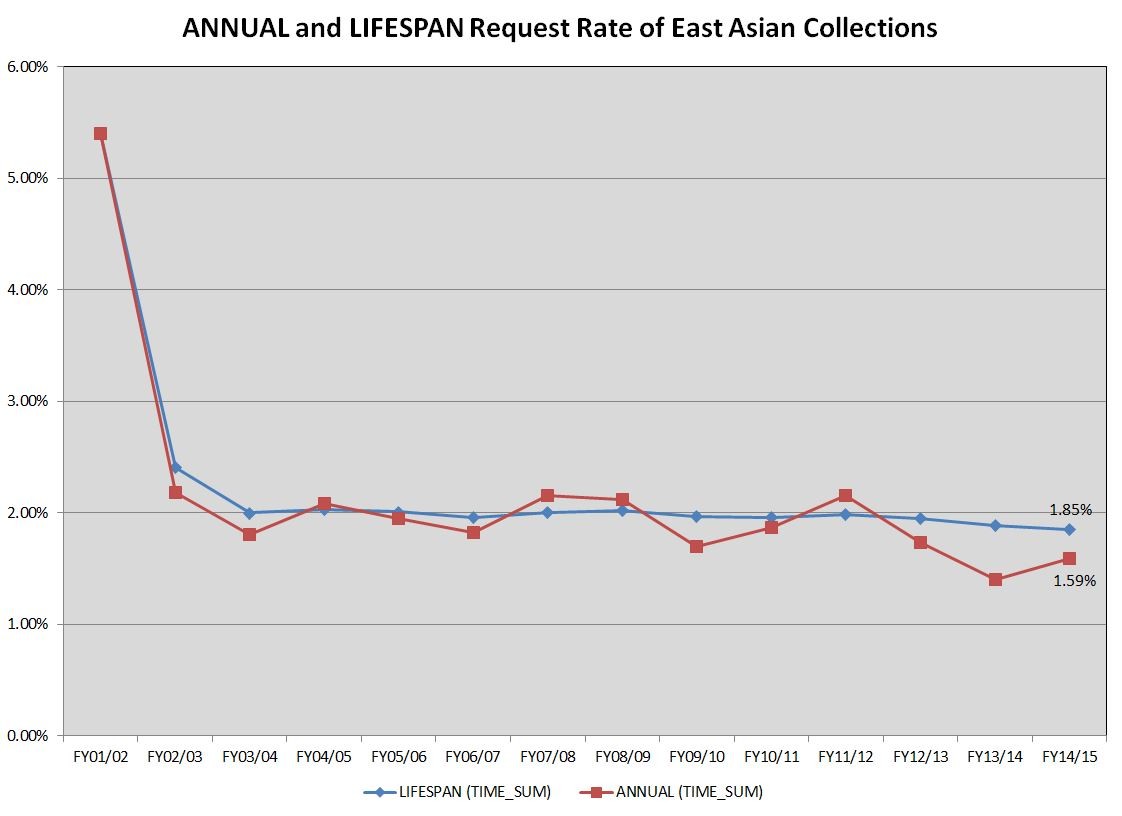
Charts
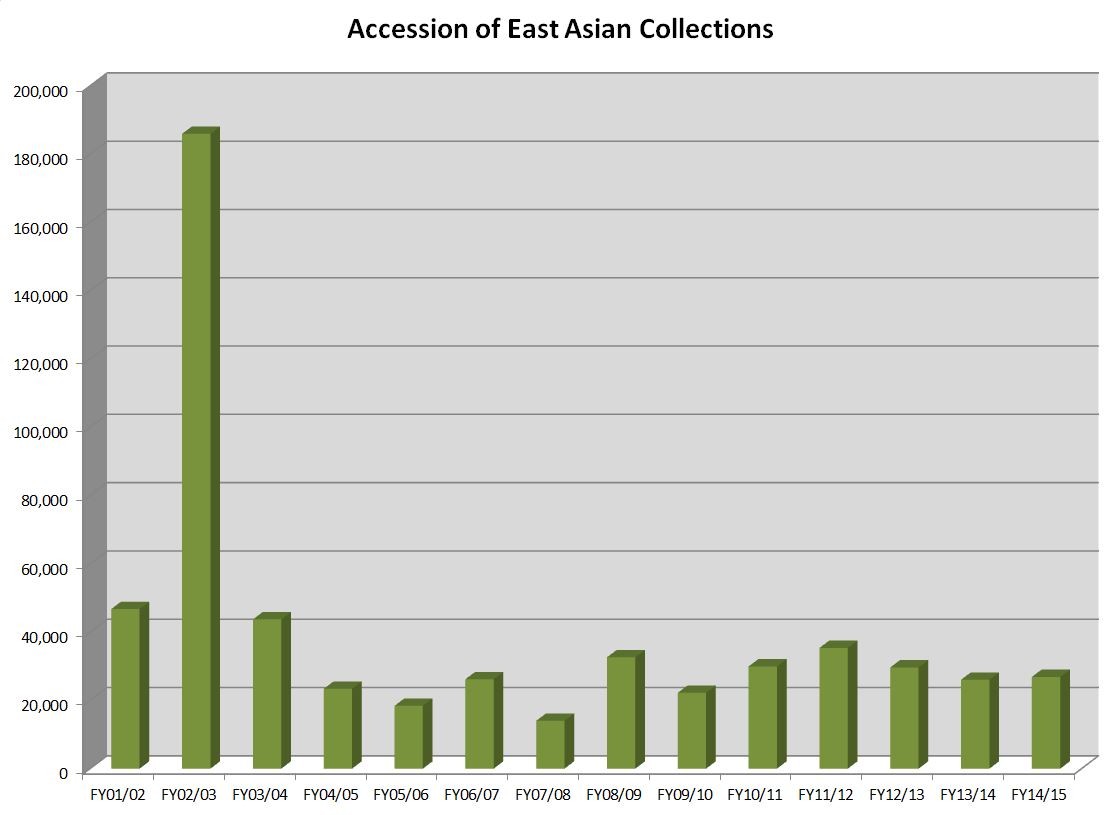
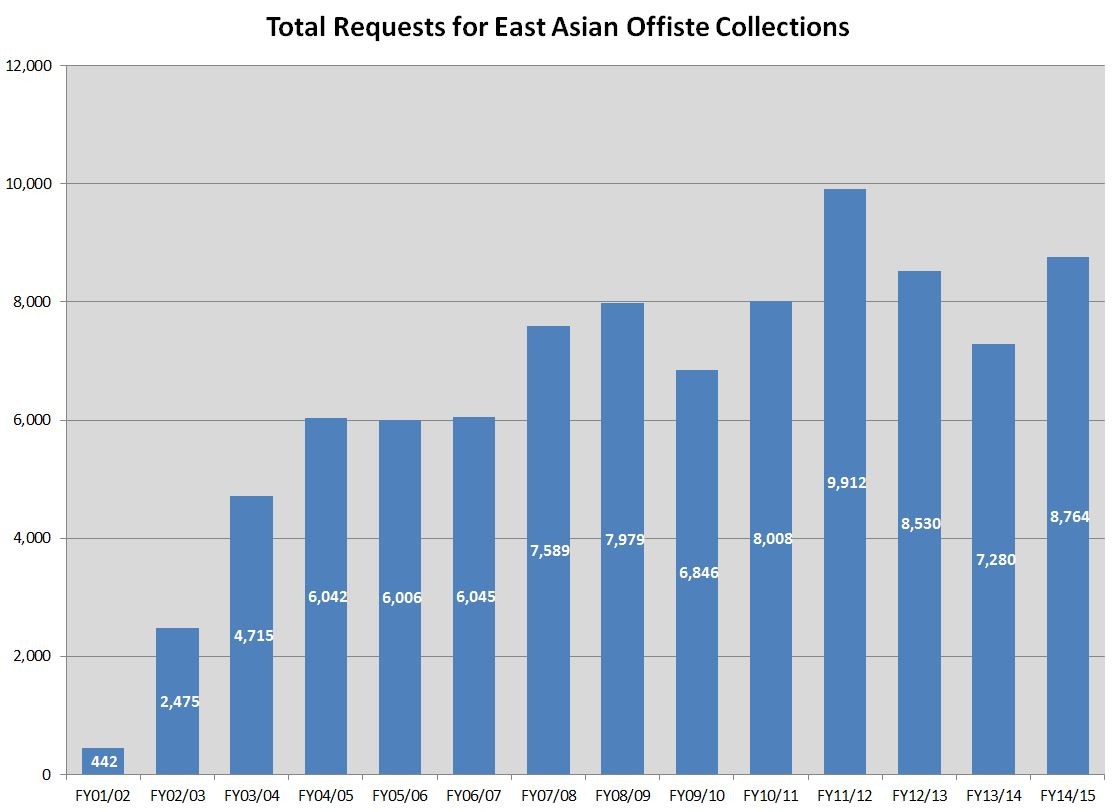
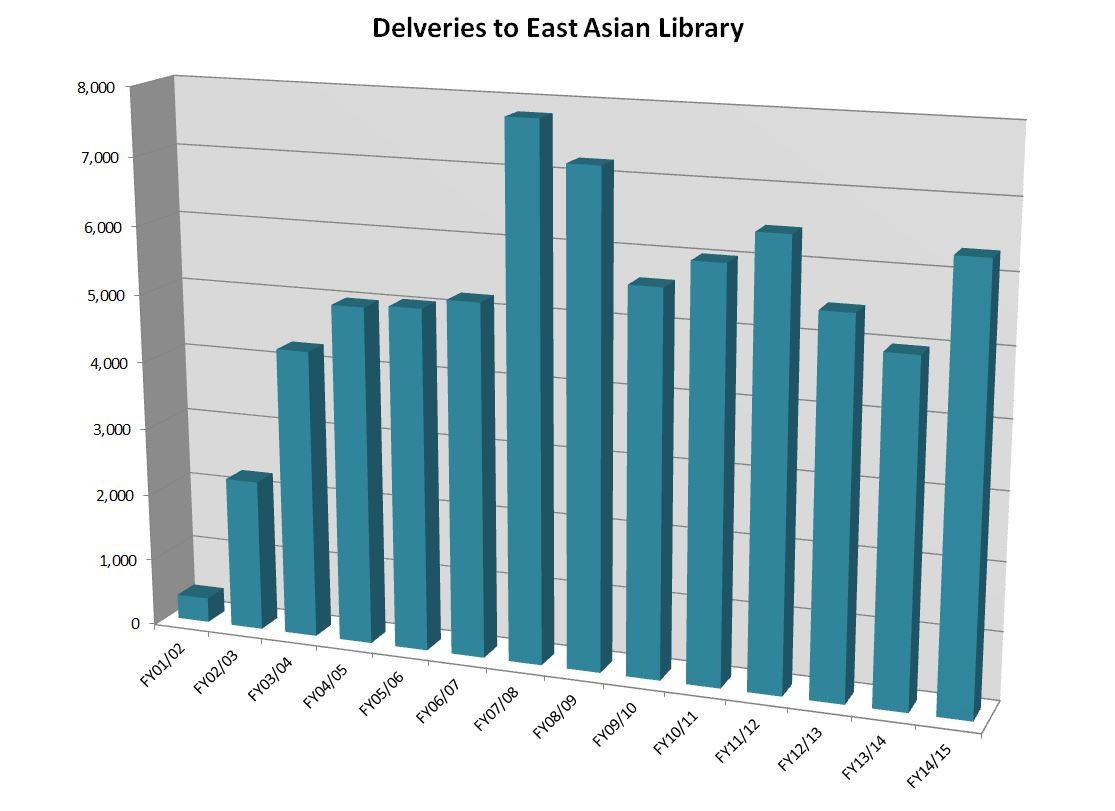
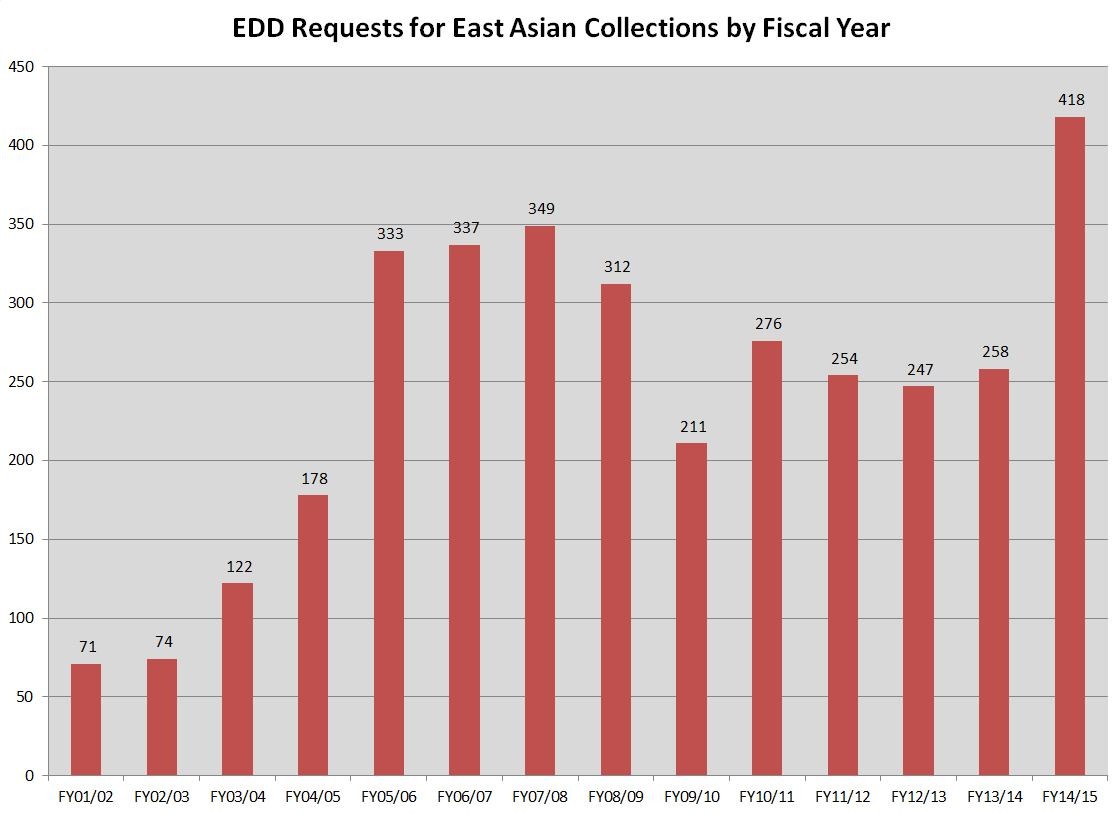
ReCAP Data by Language
East Asian ReCAP Data by Language (.xlsx) : Updated through FY14. Contains summary PivotTables of all primary categories.
East Asian Accessions by Language
| ACCESSIONS | Chinese |
Japanese |
Korean |
Tibetan | English | Other Languages |
|---|---|---|---|---|---|---|
| FY02 |
24,418 | 10,418 | 3,599 | 42 | 7,021 | 1,258 |
| FY03 |
74,148 | 96,828 | 11,354 | 533 | 2,253 | 799 |
| FY04 |
12,290 | 15,063 | 13,498 | 271 | 1,678 | 918 |
| FY05 |
8,920 | 9,022 | 2,714 | 478 | 1,673 | 573 |
| FY06 |
10,102 | 4,649 | 2,312 | 577 | 687 | 75 |
| FY07 |
11,044 | 7,490 | 5,359 | 753 | 1,414 | 119 |
| FY08 |
5,346 | 6,567 | 1,068 | 206 | 731 | 95 |
| FY09 |
10,946 | 15,286 | 3,409 |
309 | 1,994 | 685 |
| FY10 |
10,298 | 6,912 | 3,061 | 270 | 1,348 | 334 |
| FY11 |
11,424 | 10,188 | 6,247 | 379 | 1,437 | 260 |
| FY12 | 15,520 | 7,305 | 7,356 | 2,889 | 2,089 | 190 |
| FY13 | 13,036 | 6,801 | 5,801 | 2,134 |
1,521 | 346 |
| FY14 | 9,717 | 7,772 | 6,805 | 873 | 723 | 144 |
| FY15 | 10,594 | 7,329 | 7,755 | 360 | 697 | 135 |
| TOTAL |
227,804 | 211,630 | 80,338 | 10,074 | 25,266 | 5,931 |
East Asian Requests by Language
| REQUESTS | Chinese |
Japanese |
Korean |
Tibetan | English | Other Languages |
|---|---|---|---|---|---|---|
| FY02 |
103 | 187 | 11 | 0 | 137 | 4 |
| FY03 |
826 |
770 | 230 | 5 | 570 | 74 |
| FY04 |
1,779 | 1,663 | 372 | 58 | 765 | 78 |
| FY05 |
1,888 | 2,522 | 382 | 26 | 798 | 426 |
| FY06 |
2,352 | 1,873 | 560 |
43 | 1,069 | 103 |
| FY07 |
2,432 | 2,018 | 500 | 116 | 865 | 114 |
| FY08 |
2,900 | 2,968 | 503 | 166 | 958 | 94 |
| FY09 |
2,681 | 3,238 | 644 | 153 | 1,157 | 106 |
| FY10 |
2,241 | 2,644 | 832 | 151 | 885 | 93 |
| FY11 |
2,825 | 3,443 | 504 | 93 | 1,064 | 79 |
| FY12 | 3,649 | 3,345 | 1,450 | 140 | 1,209 | 119 |
| FY13 | 3,438 | 2,961 | 865 | 101 | 1,072 | 93 |
| FY14 | 3,152 | 2,498 | 545 | 129 | 872 | 84 |
| FY15 | 3,410 | 3,230 | 971 | 143 | 923 | 87 |
| TOTAL |
33,676 | 33,360 | 8,369 |
1,324 |
12,344 | 1,560 |
East Asian Deliveries by Language
| DELIVERIES | Chinese |
Japanese |
Korean |
Tibetan | English | Other Languages |
|---|---|---|---|---|---|---|
| FY02 |
65 | 164 | 2 | 0 | 122 | 12 |
| FY03 |
777 | 657 | 218 | 4 | 478 | 122 |
| FY04 |
1,657 | 1,497 | 347 | 40 | 629 | 114 |
| FY05 |
1,690 | 2,135 | 365 | 22 | 616 | 174 |
| FY06 |
2,002 | 1,516 | 508 | 37 | 845 | 144 |
| FY07 |
2,081 | 1,683 | 405 | 76 | 795 | 170 |
| FY08 |
2,427 | 2,586 | 450 | 156 | 1,205 | 987 |
| FY09 |
2,319 | 2,812 | 514 | 144 | 1,206 | 226 |
| FY10 |
1,727 | 2,115 | 349 | 143 | 1,039 | 252 |
| FY11 |
2,015 | 2,512 | 270 | 82 | 1,006 | 135 |
| FY12 | 2,415 | 2,244 | 373 | 121 | 1,155 | 162 |
| FY13 | 2,180 | 1,815 | 201 | 72 | 1,063 | 149 |
| FY14 | 2,149 | 1,426 | 280 | 116 | 870 | 147 |
| FY15 | 2,430 | 1,970 | 607 | 134 | 1,107 | 94 |
| TOTAL |
25,934 | 25,132 | 4,889 | 1,147 | 12,136 | 2,891 |
East Asian EDD by Language
| EDD | Chinese |
Japanese |
Korean |
Tibetan | English | Other Languages |
|---|---|---|---|---|---|---|
| FY02 |
36 | 22 | 8 | 0 | 5 | 0 |
| FY03 |
2 | 6 | 1 | 0 | 58 | 7 |
| FY04 |
2 | 14 | 3 | 0 | 101 | 2 |
| FY05 |
18 | 20 | 1 | 0 | 130 | 9 |
| FY06 |
45 | 75 | 4 | 5 | 189 | 15 |
| FY07 |
69 | 47 | 2 | 0 | 181 | 38 |
| FY08 |
36 | 89 | 0 | 2 | 209 | 13 |
| FY09 |
26 | 86 | 0 | 2 | 179 | 19 |
| FY10 |
27 | 73 | 5 | 2 | 92 | 12 |
| FY11 |
27 | 69 | 3 | 1 | 167 | 9 |
| FY12 | 24 | 85 | 3 | 3 | 131 | 8 |
| FY13 | 35 | 119 | 1 | 3 | 82 | 7 |
| FY14 | 46 | 124 | 25 | 0 | 59 | 4 |
| FY15 | 36 | 276 | 39 |
0 | 61 | 6 |
| TOTAL |
429 | 1,105 | 95 | 18 |
1,644 | 149 |
Request Rate by Language
Chinese = 1.53%
Japanese = 1.54%
Korean = 1.26%
Tibetan = 1.39%
English = 3.69%
Other Languages = 1.48%
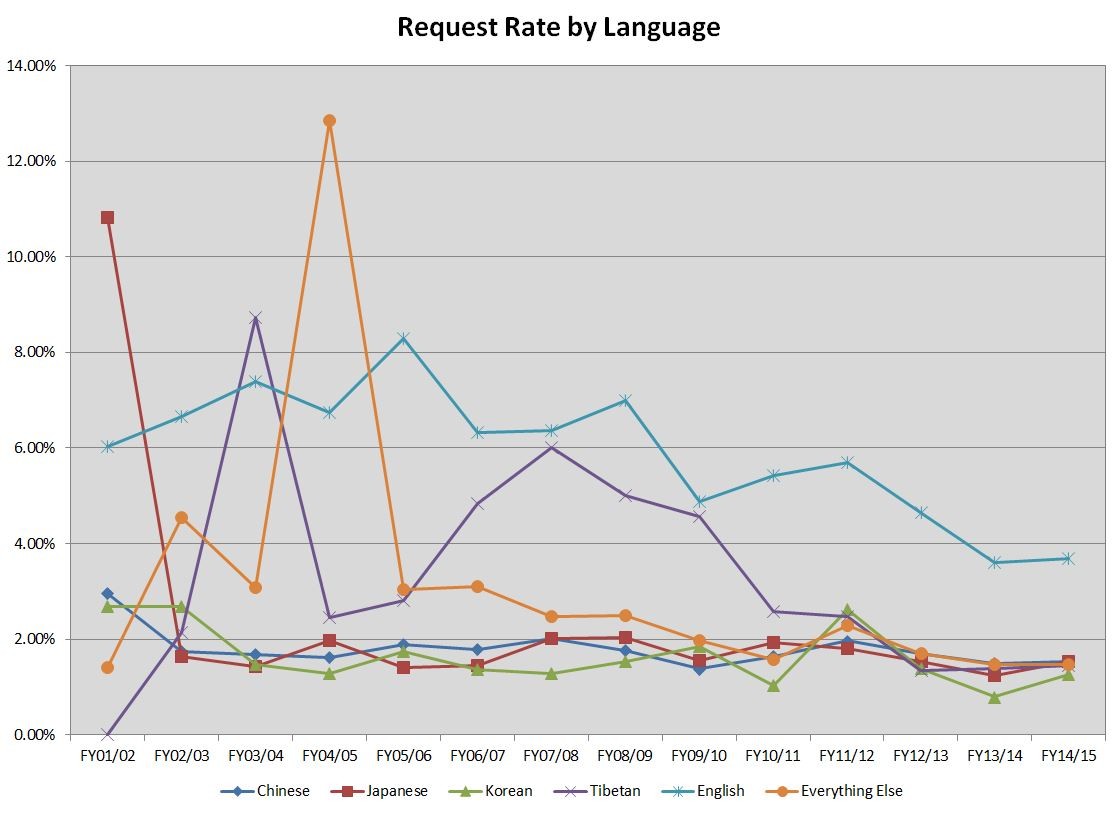
ReCAP-Related Projects at East Asian Library
Resolution of orphan barcodes (August 2010 to November 2012)
- Primary goal
Resolve 3,695 East Asian orphan barcodes with customer code EV. - Secondary goals
Improve bibliographic control of East Asian collections; collaborate with East Asian staff to correct and enchance bibliographic records and perform routine database maintenance. - History
- Weekly Accession Reports document the number of barcodes accessioned at ReCAP that are not currently in Voyager. These are listed as "records not found." CUL staff refer to these items as orphan barcodes because they not present in CLIO and currently on the shelf at ReCAP. As of Spring 2009, there were approximately 35,000 orphan barcodes.
- The majority of this number represent problems that must be resolved by staff. Some represent collections tracked by departments outside of CLIO. For example 8,731 are BS barcodes currently part of the Columbia Historical Corporate Annual Reports project and 5,570 belong to RBML collections.
- Some East Asian orphans can be identified by customer code EV. 3,695 orphan barcodes were identified with these criteria. The vast majority have dumb barcodes; only 209 have smart barcodes.
- East Asian general collections are accessioned at ReCAP with 100- and CU-prefix barcodes. Since February 2007 they accessioned with customer code CU, making these orphans impossible to distinguish from other departmental collections at ReCAP. Before 2007 East Asian accessioned CJK-language material with customer code EV.
- Staffing
Student workers; ReCAP Coordinator and Head of Technical Services at East Asian Library. - Procedure
Orphan barcodes are retrieved in small batches (50-100) from ReCAP. Staff sorts items into two sections: single-volume monographs and multi-part works. Resolution follows flowchart. Additional retrieval and staff intervention as necessary. - Documentation
- Master list of East Asian orphan barcodes
Includes 3,695 orphan barcodes accessioned with customer code EV. - Flowchart for East Asian Orphan Barcodes
Procedural flowchart for orphan problem-solving. - Voyager Guide to East Asian Collections
- Master list of East Asian orphan barcodes
Obsolete CLIO Locations
In early phases of ReCAP transfers, location xxx,anx2 was used as a transitional location for collections going to Offsite.
| CLIO Location | Total Items | Date Resolved |
|---|---|---|
| eal,anx2 | 9 | |
| eax,anx | 0 | 2/22/2012 |
| eax,anx2 | 310 | |
| pren,eax | 2,875 |

ReCAP User Inquiry Alias: recap@library.columbia.edu
Supervisor, ReCAP Access Services: Jennifer Loubriel
Phone: (212) 854-3542
E-mail: jll2223@columbia.edu
